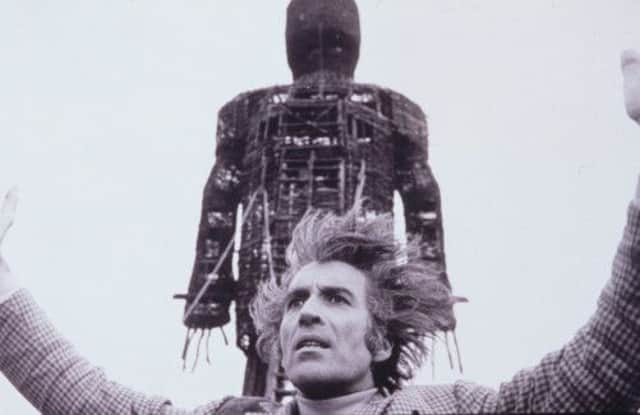Lori Anderson: Worship at the feet of The Wicker Man


When car keys skip gaily off to play hide and seek on the morning we depart on holiday, or when a precariously balanced cup of tea suddenly floods over the chintzy new sofa, our house will ring out with a clarion call of despair recognisable to a certain erudite breed of movie fans: “NO! CHRIST! NO!”
To be most effective the phrase, should really be delivered in a comic Scots accent, but we do forego the sacrificial white robe as worn by Edward Woodward who screams out the phrase at the grisly culmination of one of Scotland’s greatest movies.
Advertisement
Hide AdAdvertisement
Hide AdLet us all bow down in worship, or at least dust down our fish-face masks and codpieces, for The Wicker Man is once again lighting up the big screen. The ‘Citizen Kane of Horror films’ according to Cinefantastique is being re-released 40 years after it first limped on to the screens in a cut-down 87-minute version which was squeezed on as the B-side of a double bill with Don’t Look Now. At the time, Michael Deeley, who ran the studio, said, according to the film’s director Robin Hardy, that “The Wicker Man was one of the worst films ever made and unreleasable”. Over the next four decades those 12 missing minutes helped to create a cultish aura around what was already a brilliant and disturbing classic. There were reports that the original negative had been buried, not in some occult ceremony in a bid to contain its palpable evil, but in a clerical oversight which led to all the waste from Shepperton studio being used as landfill for the foundations of the M3 motorway.
There were reports that Rod Stewart tried to buy up the negative in a bid to protect the world from seeing his then girlfriend, Britt Ekland, seduce a fairly attractive wall, which never really made much sense as the writhing buttocks so amply displayed belonged not to Miss Ekland but to a local housewife, Jane Jackson, who stepped in and out of her clothes when the Swedish bombshell went coy. Now The Wicker Man is at last to be seen in its original glory, or as near as is ever likely to be, after StudioCanal launched a Facebook campaign earlier this year in a bid to find missing footage and succeeded in turning up a 92-minute 35mm print which had been sitting for decades in the Harvard Film Archive.
How Harvard ended up with a pristine early copy remains unclear. The film was originally sent to the American producer, Roger Corman, who also agreed with Michael Deeley that it should be cut back before being released in the states. The new version is said to have an early scene which hints at the pagan decadence of the island, in which Willow (Britt Ekland), the landlord’s daughter, is sent a male virgin by Lord Summerisle to deflower.
Based on the novel Ritual by David Pinner, but freely adapted by Anthony Shaffer, the story follows the police sergeant Howie, played by Woodward, who arrives on Summerisle in the Outer Hebrides to investigate a missing child and quickly discovers that the islanders have thrown off the ill-fitting shroud of Christianity, preferring instead to ensure a bountiful harvest by capering nakedly with the disturbing and blood-thirsty gods of their ancient pagan past.
In many ways, The Wicker Man is an anti-horror film, set not in the shadows of night but mainly during the day, with Christopher Lee playing Lord Summerisle as a smiling charmer rather than a demonic rogue. Yet it is the sense of the quotidian given a pagan twist, of schools teaching spells, of graveyards filled with copulating couples, that helps to build up so disturbing an atmosphere of unease and quiet dread.
By the end, one realises that Sergeant Howie for all his clues and deductions is but a rat in a maze whose every exit is manipulated to lead up towards The Wicker Man. We have Julius Caesar to thank for this most terrifying of lethal contraptions. The Roman Emperor wrote in his accounts of the wars in Gaul of how indigenous tribes would burn alive the most troublesome criminals in a giant man-made structure twisted from branches. The playwright Anthony Schaffer upon reading this account filed it away as: “The most alarming and imposing image that I had ever seen.”
I came away from my first viewing of The Wicker Man thinking exactly the same thought. When Howie was bound up and trapped inside, I kept thinking how is he going to be rescued and then I realised that he wasn’t. His fate was sealed and no amount of beseeching prayers to a Christian god would trigger his swift salvation, at least not in this life.
The final shot of The Wicker Man’s now flaming head collapsing to reveal the rising sun is stunning. (We should be grateful that Shaffer’s sequel, in which a thunderstorm douses the flames and Howie is rescued by a squad of fellow officers from the mainland was never made.)
Advertisement
Hide AdAdvertisement
Hide AdThere are those who laugh at The Wicker Man. They can’t see past the pagan dancing, virgins leaping over fires and villagers popping up from behind stone walls in hare and badger masks. Folk dissolve into giggles when a naked Britt Ekland rhythmically slaps the walls behind which the virginal Sergeant Howie prays for strength to maintain his sexual abstinence, but I can’t help but think what Scotland would have been like had we all abstained from a Middle-Eastern faith about which we knew little and clung stubbornly instead to the old gods that fitted into this cold and craggy landscape. Forty years on, many of us continue to worship at the feet of The Wicker Man.
• The Wicker Man: The Final Cut is released in cinemas on 27 September and on DVD on 14 October.